“All the menageries in the world turned loose would not compare to the sight I saw that day.” Those were the words of American trader G. McKeiran in 1876 when he first trekked to the land that would become Namibia’s Etosha National Park.
We rolled into Etosha 250km from Swakopmund as the crow flies in the heat of mid-afternoon, 27th of October. We campers scurried around to set up tents in a dry, open and none too shaded campground – game drive in an hour and we were anxious to see what Etosha held for us. All the following gallery shots came from one afternoon in Etosha.
Looking at the SW coast of Africa, you can see in the lower left corner of the map the poetically named Swakopmund where we had just left and in the upper center-right, a largish white area: the Etosha Pan an endorheic basin where water goes in, salts remain and nothing flows out.
In Etosha the idea of zoo is turned inside out – people are in cages or in steel-sided trucks like Benji or the ubiquitous Toyota Land Cruisers. A 850km long (500+ miles) 5 meter high fence surrounds the park (this to keep pestilence out). Your vehicle crosses through one of two gates to the camping areas – we stayed in both Okakueljo and Namutoni. You then drive across the animals’ territory where they have the right of way and you must drive no more than 60kph (35mph).
Eventually you come to another enclosure in which is your campsite and other amenities like swimming pool, bar with cold G&T’s (mmmm….the best thing for heat exhaustion), rhinoceros viewing stands (really), bungalows, a hotel, and then there was the hard dirt, barren area where we stayed. As we cruised through the gate two elephants were laying waste to the moringa trees just outside the fence.
Little did we know what sort of hellish campsite awaited in the next of the great national parks, Chobe in Botswana. In Etosha we had a small kitchen area, screened with doors (nice for keeping the jackals and crows out) in which there were 220v electricity – we learned that you don’t take anything for granted crossing Africa.
Etosha has been a national park since 1907 – then largest game reserve in the world by the Germans in SW Africa. Name. The word etosha either means 1. place of dry water, 2. mirage or, according to other sources, 3. huge, white area. All of those describe the great rolling national park, once the largest in the world. Etosha is entered by one of two gates: Okaukuejo or Namutoni and the road runs along the side of the park – naturally you can’t drive cross country but there are many dirt roads that lead to the artificially enhanced water holes. We saw 8-10 of these water holes and I’m told there are 50 in Etosha for which the animals are very, very grateful as were the tourists who depend upon this for a place to view game.
The park is roughly 130km by 50km – dominated by salt pan. Average rainfall figures: Okaukuejo: 412 mm, Halali: 430 mm, Namutoni: 442 mm. Those are roughly 16 inches of rain per year, falling between November and February. Etosha used to be much wetter with the Kunene river running into the pan forming a large lake – this thousands of years ago. We were there just before the start of the four month wet season.
Savannah grassland and Mopani woodland surround the Pan (off limits though roads skirt its edges). Low lying, dry alkaline soil growing the dense, hard to work mopani/mopane tree.
This harsh dry land with little vegetation and salty water if any at all supports little wildlife all year round but is used by a large number of migratory birds. In particularly rainy years the Etosha pan becomes a lake approximately 10 cm in depth and becomes a breeding ground for flamingos, which arrive in their thousands, and White Pelican (Pelecanus onocrotalus). The surrounding savanna is home to a number of mammals that will visit the pan and surrounding waterholes when there is water, these include quite large numbers of zebra (Equus burchelli), Blue Wildebeest (Connocheatus taurinus), and springbok (Antidorcas marsupialis) as well as black rhinoceros, elephants, hunting dogs (my notes say we saw them but my camera is silent), lions, leopards, and antelopes.
I was more eager to see Etosha than any spot in Africa having seen the National Geographic Living Edens special on Etosha in 1997 or 1998 – the name is magic in my mind. We watched the NatGeo video a couple nights ago as a refresher and every animal that those great photographers showed, we saw with one exception: the African Wild Cat.
And in fact saw and photographed many, many more. The following gallery is from the first half day in Etosha – click to enlarge an image.
- A Long Neck Comes In Handy
- Oryx By Water Hole
- Burchell’s Zebra – Etosha
- View From Truck Window
- Zebras Drinking
- Kori Bustard – Etosha, Namibia
- Leopard Etosha Dusk Drinking
- Leopard Etosha Dusk
- Rhinos at viewing area – Okakueljo campsite
- Benji, tents, kitchen bldg. at Etosha










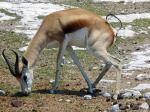










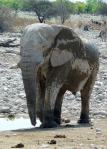

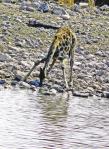

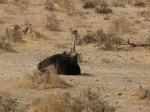





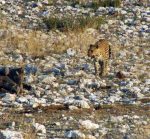
























When the Etosha national park was established in 1907, it was the largest game park in the world. But political pressures over time has reduced it to a quarter of its original size. Even then it has not lost its charm and your photos are a proof of it.
What great photos but what an almost Hellish place to live in.Thanks for all the info which was mostly all new to me.
Thanks, Sol!
It would be very difficult for humans or even primates – we saw none (primates) though the current idea is that our ancestors moved out of the trees onto the plains. Etosha is flat but varied – I expect the amount of minerals in the soil has a lot to do with that – the salt flat is pretty barren. Still there are small hills and rocky outcroppings, small forests of trees, so may not be quite as grim as some of the pictures make it look.
One of the next posts shows an elephant in the trees – one of my favorite images and maybe it’ll give a more rounded picture of the place. I wouldn’t want to live there!